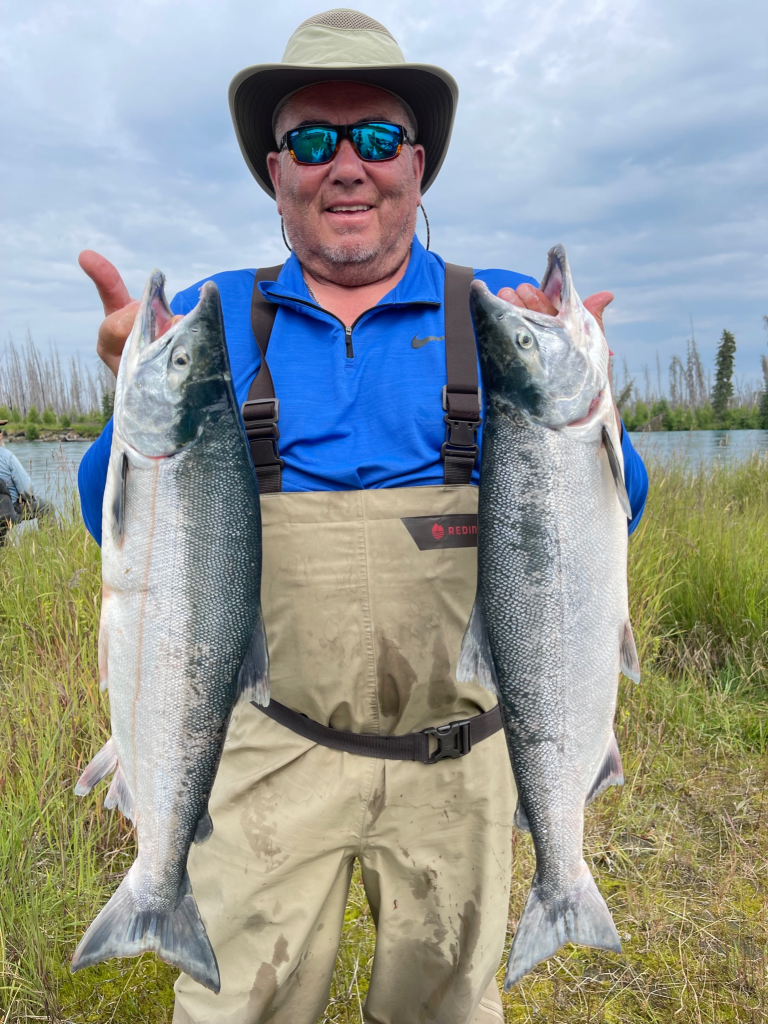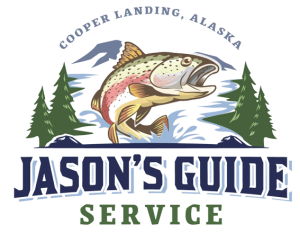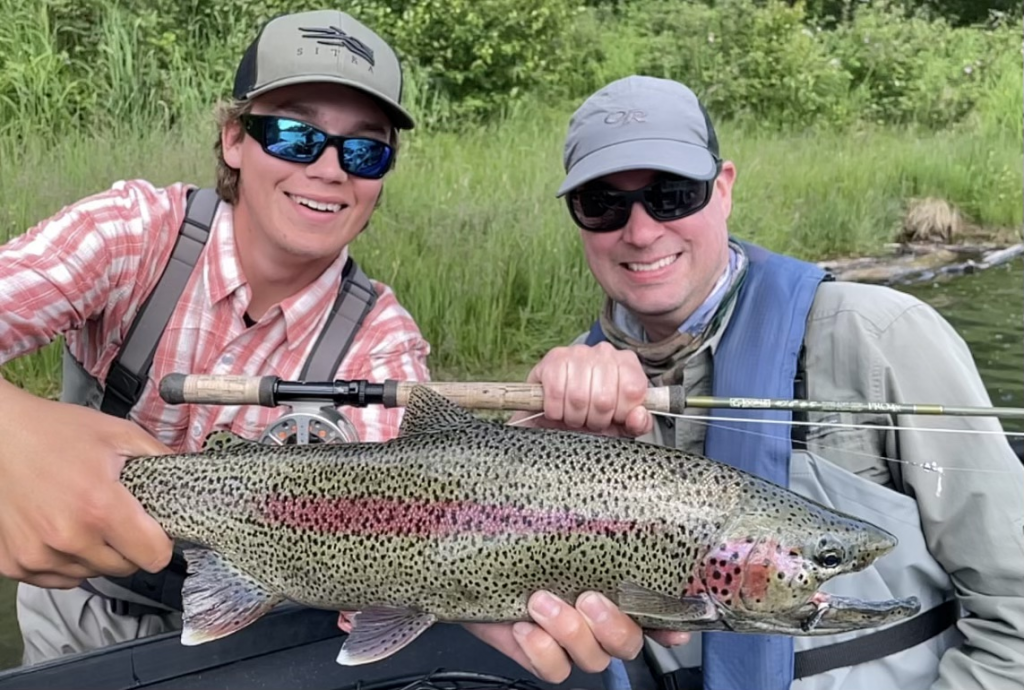Nestled in the heart of Alaska, the Kenai River is a fly fisher’s paradise, renowned for its stunning landscapes and abundant fish populations. This legendary river draws anglers from around the globe, eager to test their skills against its formidable rainbow trout and king salmon. Fly fishing on the Kenai is more than just a sport; it’s a journey into nature’s wonders and a dance with some of the most prized fish in the world.
To truly master fly fishing on the Kenai River, one must go beyond the basics. This guide delves into these advanced elements, providing you with tips for fly fishing to elevate your experience on the Kenai River.
Gearing Up for Success
Rod Selection
Choosing the right rod is crucial for success on the Kenai. For rainbow trout, a 6-7 weight rod with a medium-fast action offers the versatility needed to handle varying conditions and fish sizes. When targeting king salmon, opt for an 8-9 weight rod with a fast action to provide the power required to battle these strong fighters.
Reel Selection
A high-quality reel with a reliable drag system is essential, especially when pursuing larger fish like king salmon. Look for reels with smooth, adjustable drag capabilities and robust construction to withstand the vigorous runs and weight of these fish.
Fly Line Selection
Fly line choice can significantly impact your presentation and success. Floating lines are ideal for dry fly fishing and shallow waters while sinking and sinking-tip lines are better suited for deeper runs and presenting flies at varying depths. Having a selection of lines allows you to adapt to different fishing scenarios on the Kenai.
Leader and Tippet Construction
The leader and tippet play a critical role in the fly presentation. Use a tapered leader that transitions smoothly from thick to thin to reduce drag and improve casting accuracy. Match your tippet strength to the size of the fish and flies you’re using; for rainbow trout, a 4-6x tippet works well, while for king salmon, a stronger 0-2x tippet is necessary.
Fly Selection
Essential fly patterns for the Kenai include dry flies like the Adams and Elk Hair Caddis for rainbow trout and nymphs such as the Hare’s Ear and Pheasant Tail for subsurface fishing. Streamers like the Woolly Bugger and Egg-Sucking Leech are effective for both trout and salmon, mimicking baitfish and triggering aggressive strikes.
Mastering the Art of the Cast
Importance of Proper Casting Technique
Accurate and effective casting is vital for successful fly fishing. Proper technique ensures your fly lands where intended, mimicking natural insect movements to entice fish. Practice makes perfect, and honing your casting skills will pay off on the Kenai.
Different Casting Styles
For beginners, single-hand spey and roll casting are useful techniques, especially in tight spots where space is limited. Experienced anglers might prefer double-haul casting for increased distance and precision. Each style has its place depending on the fishing conditions and your skill level.
False Casting and Line Control
False casting helps in adjusting the length of your line and positioning your fly accurately. Mastering this technique, along with mending (adjusting the line’s position on the water to control the drift), ensures your fly drifts naturally with the current, increasing the likelihood of a strike.
Wind Management
Wind can be a significant challenge on the Kenai. Learning to cast against or across the wind by altering your casting angle and using wind-resistant fly patterns can make a substantial difference in your success rate.

Reading the River – Decoding the Water
Identifying Productive Fishing Areas
Understanding where fish are likely to be found is key. Look for riffles, runs, pools, and seams—areas where the current changes speed and direction, providing prime feeding spots for fish.
Reading Water Current
Fish behavior varies with water speed. Faster currents often attract more aggressive fish looking for food, while slower waters serve as resting areas for holding fish. Adjust your tactics accordingly.
Underwater Features
Features like rocks, logs, and weed beds provide cover and ambush points for fish. These structures can hold significant numbers of fish and should be targeted with precise casts and well-chosen flies.
Reading Hatches
Successful fly fishing involves matching your fly to the local insect activity. Pay attention to emerging insects and adjust your fly selection to mimic the prevalent hatch, whether it’s mayflies, caddisflies, or midges.
Targeting Trophy Trout
Dry Fly Fishing Techniques
When dry fly fishing, achieving a dead drift—where the fly floats naturally with the current—is crucial. Employ drag-free drifts by adjusting your line and leader, and be ready to strike quickly when a trout takes your fly.
Nymph Fishing Techniques
Nymphing can be highly effective for trout. Techniques like upstream nymphing and Euro nymphing, which use weighted flies to reach deeper levels, can yield impressive results. Adjust your weights to keep the fly close to the riverbed where trout feed.
Streamer Fishing
Streamers imitate baitfish and can provoke aggressive strikes from large rainbow trout. Cast across runs and retrieve your streamer with varying speeds to entice predatory trout.
Catch and Release Techniques
Practicing catch and release helps preserve fish populations. Use barbless hooks, handle fish with wet hands to protect their slime coat, and employ a soft-mesh net to minimize injury. Revive fish in the current before releasing them back into the water.
The Thrill of the King
Challenges of King Salmon Fishing
King salmon are known for their powerful runs and size, requiring robust tackle and strong lines. Larger flies and heavier rods are necessary to handle these formidable fish.
Techniques for King Salmon
Swinging flies across runs and using weighted flies to reach deeper water are effective strategies. Focus on deep pools and strong currents where king salmon are likely to be found.
Fighting Large Fish
Fighting king salmon demands patience and strategy. Allow the fish to run while maintaining controlled pressure. Use the current to your advantage, and avoid overexerting the fish to ensure a successful catch and release.
Regulations
Stay informed about regulations regarding king salmon fishing, including season dates, size limits, and bag limits, to ensure compliance and conservation.
A Respectful Approach
Respecting the Kenai River ecosystem is paramount. Practice leave-no-trace principles by packing out all trash, minimizing gear impact, and handling fish responsibly. Adhere to fishing regulations and respect fellow anglers. Contribute to conservation efforts to preserve this remarkable fishery for future generations.
For an unparalleled fly fishing experience on the Kenai River, book a guided fishing trip with us at Jason’s Guide Service. We specialize in salmon fishing in Cooper Landing and guided rainbow trout fishing, ensuring you have the best chance of landing trophy fish in this legendary river. Our expert guides are deeply knowledgeable about the river’s dynamics, the best fishing spots, and the most effective techniques.


